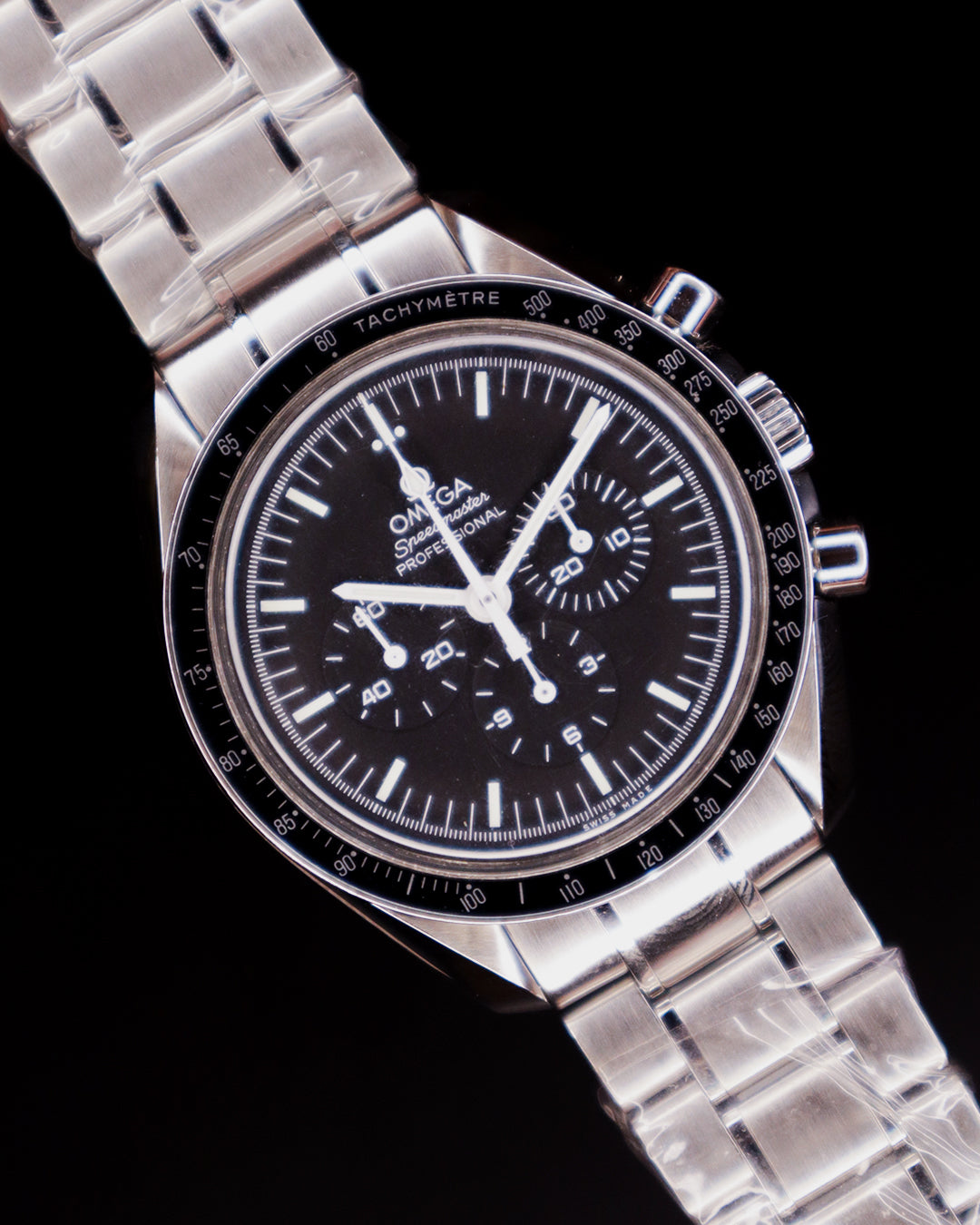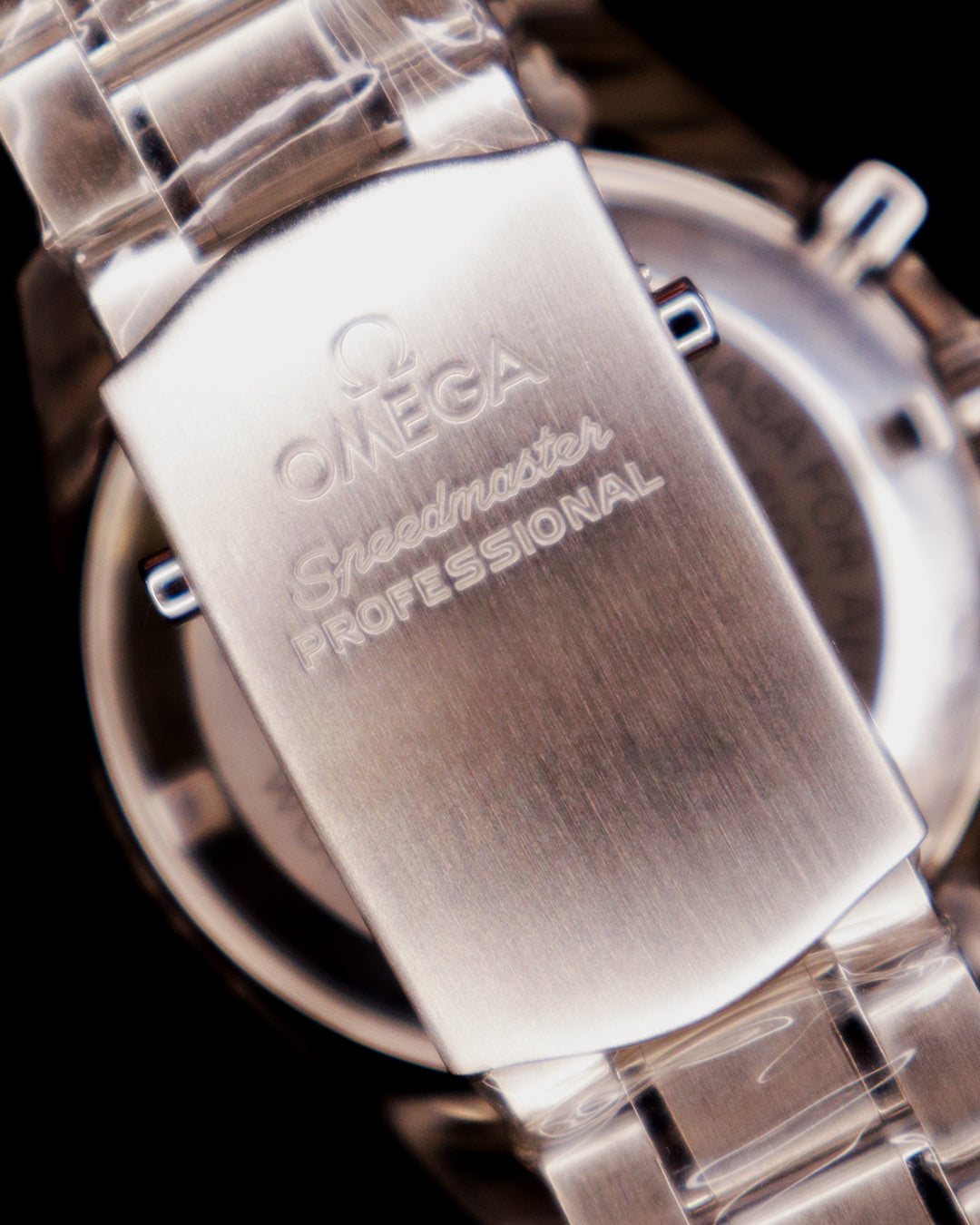In the world of mechanical watches, few names carry the weight of the Omega Speedmaster Moonwatch. From racetracks to lunar dust, its journey is one of design brilliance, engineering endurance, and cultural permanence.
But what makes the Moonwatch special isn’t just the fact that it went to the Moon. It’s how it got there, why it was chosen, and what its evolution says about the strange alchemy of form, function, and myth.
Introduced in 1957, the original Speedmaster (CK2915) was intended for motorsports—featuring “Broad Arrow” hands and the industry’s first tachymeter bezel. But in 1962, astronaut Wally Schirra privately wore one aboard Mercury-Atlas 8, setting the stage for its transformation. Two years later, When NASA began testing chronographs in 1964 for manned missions, the Speedmaster outperformed all rivals to become the official flight-qualified watch.
On July 21, 1969, Buzz Aldrin stepped onto the lunar surface with a Speedmaster strapped over his spacesuit. Aldrin’s Speedmaster, the first watch worn on the Moon wasn’t designed for lunar missions, yet it endured the impossible - helping to build one of the most compelling origin stories in horology.
In 1970, amid the crisis of Apollo 13, astronauts used their Speedmasters to time a critical 14-second engine burn to ensure safe re-entry; earning Omega NASA’s Silver Snoopy Award; an honour reserved for exceptional contributions to human spaceflight.
Early Speedmasters featured the Caliber 321, a column-wheel chronograph movement. In 1968, Omega introduced the Caliber 861, a more robust and production-efficient cam-actuated movement; followed by the 1861, and in 2021, the Co-Axial Master Chronometer Caliber 3861—featuring hacking seconds, anti-magnetic materials, and METAS certification.
Still, the Caliber 321 retained near-mythic status. In 2019, Omega brought it back using tomography scans of original NASA-issued watches.
Beyond its space voyage, the Moonwatch has remained embedded in pop culture—featured in films such as Apollo 13 and First Man, referenced in literature, and revived for mass audiences via the 2022 MoonSwatch collaboration.
Technical Details:
| Brand |
Omega |
| Model |
Speedmaster Professional "Moonwatch" |
| Reference Number |
311.30.42.30.01.005 |
| Case Diameter |
42 mm |
| Case Material |
Stainless Steel |
| Crystal |
Hesalite (front), Solid steel caseback (engraved) |
| Bezel |
Fixed, black aluminum insert with tachymeter scale |
| Movement |
Omega Caliber 1861 (Manual-winding chronograph) |
| Power Reserve |
48 hours |
| Functions |
Hours, minutes, small seconds, chronograph |
| Dial |
Black with luminous hour markers and hands |
| Bracelet |
Stainless Steel |
| Lug Width |
20 mm |
| Water Resistance |
50 meters / 167 feet |
| Case Back |
Engraved with “Flight-Qualified by NASA for all Manned Space Missions” and “The First Watch Worn on the Moon” |
| Box & Papers |
No |
![Omega Speedmaster Professional 'Moonwatch' - Ref. 311.30.42.30.01.005 [42mm]](http://www.therevolverclub.com/cdn/shop/files/moonwatch-website.jpg?v=1754110544&width=1080)
![Omega Speedmaster Professional 'Moonwatch' - Ref. 311.30.42.30.01.005 [42mm]](http://www.therevolverclub.com/cdn/shop/files/moonwatch-website.jpg?v=1754110544&width=1080)
![Omega Speedmaster Professional 'Moonwatch' - Ref. 311.30.42.30.01.005 [42mm]](http://www.therevolverclub.com/cdn/shop/files/moonwatch-img-12.jpg?v=1754110544&width=1080)
![Omega Speedmaster Professional 'Moonwatch' - Ref. 311.30.42.30.01.005 [42mm]](http://www.therevolverclub.com/cdn/shop/files/moonwatch-img-12.jpg?v=1754110544&width=1080)
![Omega Speedmaster Professional 'Moonwatch' - Ref. 311.30.42.30.01.005 [42mm]](http://www.therevolverclub.com/cdn/shop/files/moonwatch-img-11.jpg?v=1754110544&width=1080)
![Omega Speedmaster Professional 'Moonwatch' - Ref. 311.30.42.30.01.005 [42mm]](http://www.therevolverclub.com/cdn/shop/files/moonwatch-img-11.jpg?v=1754110544&width=1080)
![Omega Speedmaster Professional 'Moonwatch' - Ref. 311.30.42.30.01.005 [42mm]](http://www.therevolverclub.com/cdn/shop/files/moonwatch-img-10.jpg?v=1754110544&width=1080)
![Omega Speedmaster Professional 'Moonwatch' - Ref. 311.30.42.30.01.005 [42mm]](http://www.therevolverclub.com/cdn/shop/files/moonwatch-img-10.jpg?v=1754110544&width=1080)
![Omega Speedmaster Professional 'Moonwatch' - Ref. 311.30.42.30.01.005 [42mm]](http://www.therevolverclub.com/cdn/shop/files/moonwatch-img-9.jpg?v=1754110544&width=1080)
![Omega Speedmaster Professional 'Moonwatch' - Ref. 311.30.42.30.01.005 [42mm]](http://www.therevolverclub.com/cdn/shop/files/moonwatch-img-9.jpg?v=1754110544&width=1080)










![Omega Speedmaster Professional 'Moonwatch' - Ref. 311.30.42.30.01.005 [42mm]](http://www.therevolverclub.com/cdn/shop/files/moonwatch-website.jpg?v=1754110544&width=1080)
![Omega Speedmaster Professional 'Moonwatch' - Ref. 311.30.42.30.01.005 [42mm]](http://www.therevolverclub.com/cdn/shop/files/moonwatch-img-12.jpg?v=1754110544&width=1080)
![Omega Speedmaster Professional 'Moonwatch' - Ref. 311.30.42.30.01.005 [42mm]](http://www.therevolverclub.com/cdn/shop/files/moonwatch-img-11.jpg?v=1754110544&width=1080)
![Omega Speedmaster Professional 'Moonwatch' - Ref. 311.30.42.30.01.005 [42mm]](http://www.therevolverclub.com/cdn/shop/files/moonwatch-img-10.jpg?v=1754110544&width=1080)
![Omega Speedmaster Professional 'Moonwatch' - Ref. 311.30.42.30.01.005 [42mm]](http://www.therevolverclub.com/cdn/shop/files/moonwatch-img-9.jpg?v=1754110544&width=1080)


